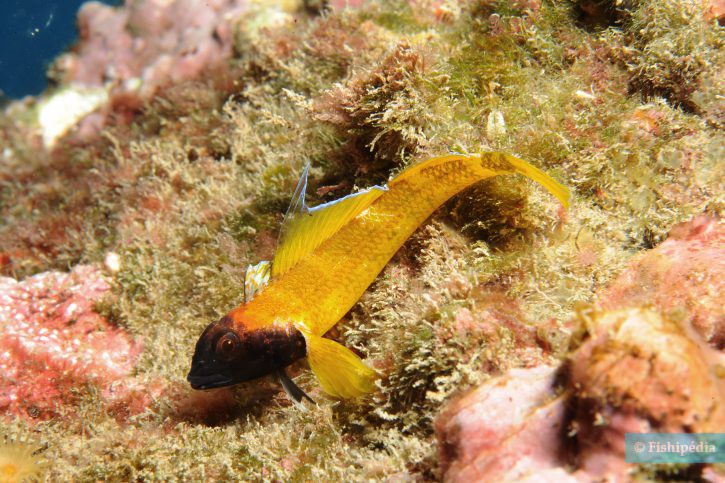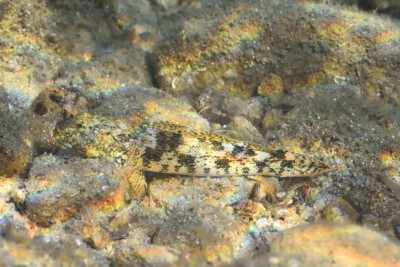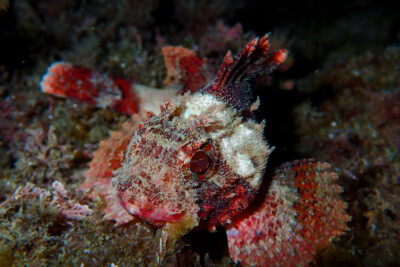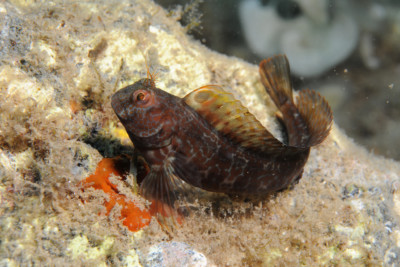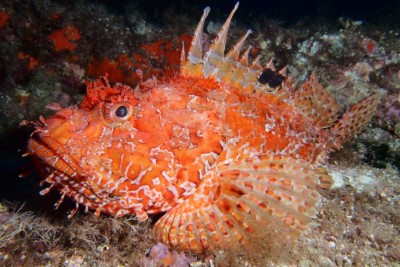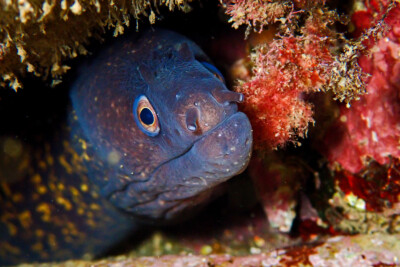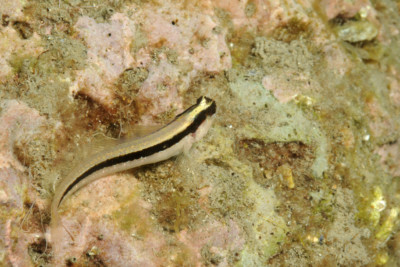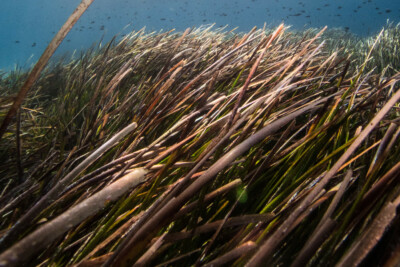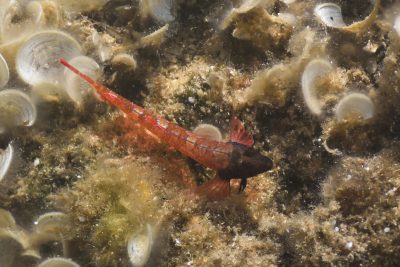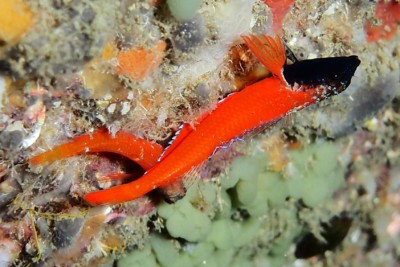black-faced blenny
| Family | Tripterygiidae |
|---|---|
| Genus | Tripterygion |
| IUCN category (World) | LC |
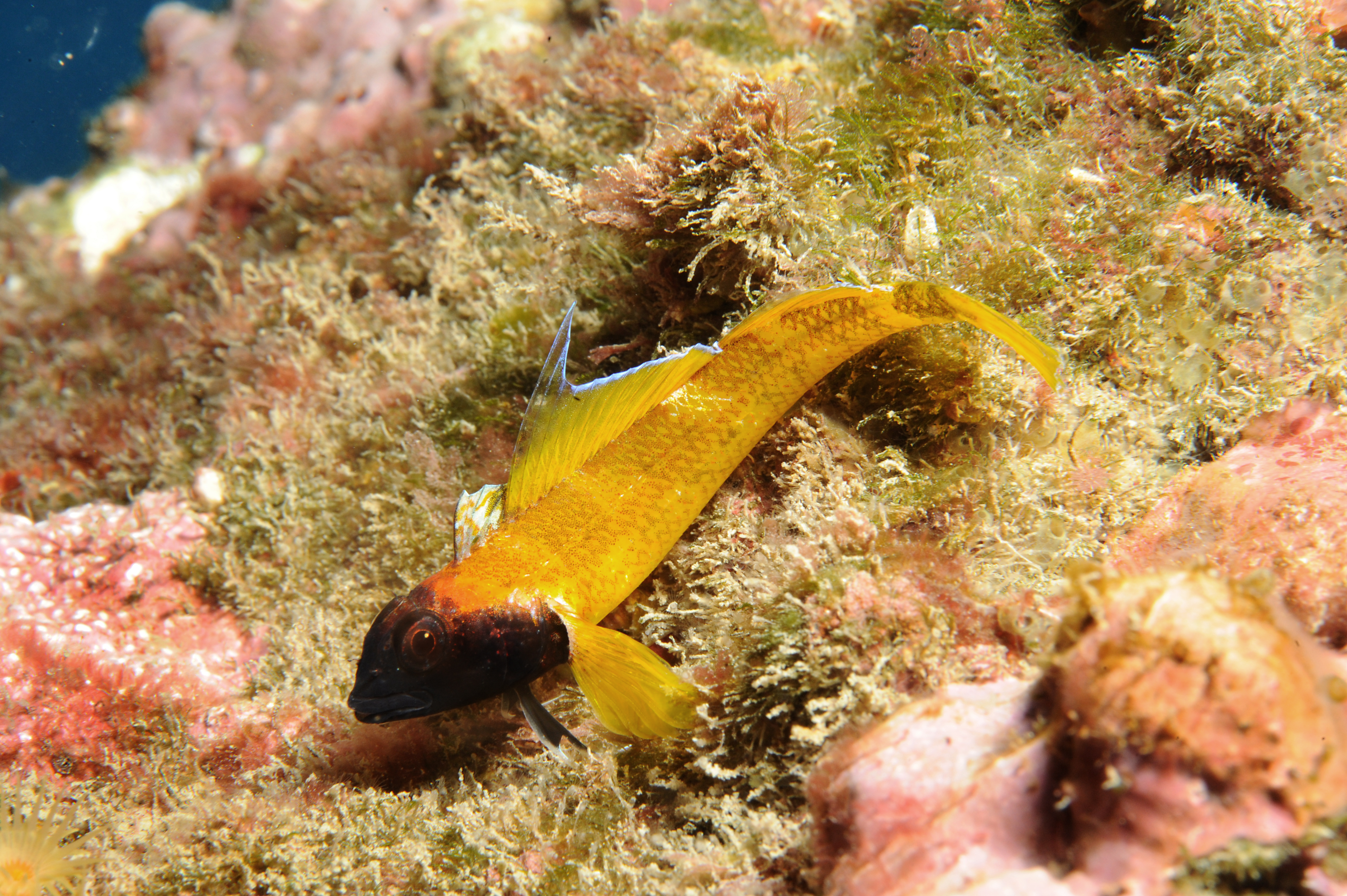

Introduction
Tripterygion delaisie is a small benthic fish found in the Mediterranean and on the eastern coast of the Atlantic Ocean. It is sometimes called black-faced blenny.
Impossible to confuse with its black head, it is one of the most colorful species on the coasts of Southern Europe. Like its congeners, its eyes are bioluminescent (red), an evolution that enhances its abilities to detect prey and avoid predators. It also has the ability to orient its eyes in all directions, like chameleons.
Who is it?
Morphology
-
Type
-
Average size6 cm
-
Maximum size9 cm
-
Patternvertical stripes
-
Type
-
Average size6 cm
-
Maximum size9 cm
-
Patternvertical stripes
How to recognize This fish ?
The black-faced blenny is two-colored with a black head and yellow body. Upon closer observation, brownish vertical stripes can be seen throughout the body. The head is covered with small shiny spots like other Tripterygion species.
Behaviour & Life cycle
-
dietcarnivorous
-
Sociabilitysolitary
-
territorialYes
-
Way of livingdiurnal
The black-faced blenny is a territorial fish that lives solitarily outside the breeding period. On the Atlantic coast, it is found in shallow biotopes exposed to light. In the Mediterranean, it competes with the red black-faced blenny and is more often observed in shaded areas near faults and caves.
Dominant males are territorial. However, outside of breeding, confrontations and intimidation displays are rare. Like the red black-faced blenny, this micro-predator feeds on benthic invertebrates which it quickly aspirates with its mouth.
Reproduction
-
Reproductionovipare qui dépose ses Œufs dans la végétation
The behavior of the three Mediterranean Tripterygion species is relatively similar but differs in some aspects. T. delaisi diverges in terms of courtship movements. Like in T. tripteronotus, spawning takes place on a site composed of rocks covered with small green and brown algae. When a female enters the territory of a mature male, he courts her. A courtship characterized by close undulatory movements begins.
Following these exchanges, if the male invites the female to follow him into his territory. If she accepts, spawning begins. Reproduction is divided into two phases. During the first, the female slowly moves along the substrate rubbing her body, likely searching for the best spawning site. The eggs are then laid and fertilized in the vegetation. They are hemispherical and covered with numerous sticky filaments anchoring them in the algae.
After spawning, the female leaves the territory and the male guards and cleans the eggs. In the male's absence, the eggs are all devoured by neighboring predators such as wrasse, juvenile sea bream, blennies, scorpionfish, or crabs. During surveillance, the male chases away crabs and blennies using its body. It also bites intruders on the flanks and fins. It cannot defend against sea urchins which can come to graze on the algae and destroy the eggs in the process. Sometimes, another male may displace the male protecting the eggs. When this happens, the latter devours the eggs.
The eggs are diligently cleaned by the male. In the absence of the male, algae grow, and no larvae hatch. The agitation of marine waters brings in bits of algae and small stones that must be regularly removed from the spawn.
Upon hatching, after about twenty days, in water around 20°C, the male picks up certain larvae and spits them out of the territory. These larvae swim towards the light and are carried away by the current. This behavior is not systematic and could serve as a kind of assistance for the most struggling larvae. Once carried away, the larvae become part of the zooplankton close to the coast.
The larvae live among the plankton for several weeks. The post-larvae return when they reach a size of about 2 cm.
Harmless species
This species does not represent any particular threats to humans when encountered in its natural environment.
Origin and distribution
Geographic distribution & Conservation
Tripterygion delaisi is present in the Eastern Atlantic, from the south of the UK and the English Channel to Senegal, as well as in the Mediterranean. Its range also includes Madeira and the Canary Islands.
Conservation status of populations (IUCN)
What is its habitat?
Natural environment characteristics
-
Temperature16 - 28 °C
-
Depth0 - 40 m
Biotope presentation
The black-faced blenny occupies rocky coastal areas between 1 and 40 m deep. This demersal species favors rocky substrates, overhangs, cave entrances, and other habitats with reduced light, although it also frequents shallow areas more exposed to light in the Atlantic.
Species of the same biotope
Main recommendations for fishkeeping
Deontology
In order to preserve wildlife, if you acquire this animal, it must not be released into the wild. See also, the Fishipedia charter.
Fishipedia supports the practice of responsible and environmentally friendly aquarium keeping. We encourage maintenance if it is motivated by a desire to understand the biological functioning of living things and if it is done with respect for animal life.
We believe that aquaristics is an opening to the discovery of aquatic environments, especially freshwater, and that this knowledge is necessary to better protect and respect these environments. Logically, we refute the compulsive purchase of animals that would not find a sufficient and / or adapted place in the host aquarium.
Our recommendations
-
Min volume200 liters
-
Population min1
-
Temperature16 - 28 °C
Characteristics
-
Difficulty breedingunknown
-
Robustnessrobust
-
Behaviourslightly aggressive
-
Availabilityrare
General reminders
It is strongly advised to read the complete dedicated file and to get information on the feedbacks of maintenance of the envisaged animal, this to avoid any potential conflict whose end result is generally the death of the individual (or the other inhabitants). It is important not to overload your aquarium to limit pollution. This will make maintenance easier.
General reminder on maintenance datas
Le démarrage d'un aquarium est une partie primordiale pour l'équilibre et le bien-être des poissons. Lorsque l'on met en eau un aquarium, l'eau passe naturellement par un cycle biologique : le cycle de l'azote. Celui-ci dure environ trois semaines. Tous les 2 jours, nous vous conseillons de tester votre eau jusqu'à ce que le taux de nitrite soit à zéro pendant plusieurs jours d'affilée.
Pour accélérer ce cycle, vous pouvez utiliser un activateur de bactéries comme JBL Denitrol. Cette solution riche en bactéries vivantes et enzymes permet une mise en place rapide du cycle de l'azote. Les poissons peuvent alors être introduits plus rapidement.
Il est important de tester l'eau de son aquarium régulièrement pour maintenir un environnement sain pour les poissons et les autres habitants. Les tests d'eau permettent de mesurer les niveaux de différents paramètres tels que le pH, la dureté totale, ainsi que les taux de nitrates, de nitrites et d'ammoniaque.
Pour réaliser ces tests, vous pouvez utiliser des produits d'analyse spécialisés tels que JBL ProScan qui permet de réaliser un diagnostic de l'eau directement via un smartphone. Il existe également des coffrets de tests plus classiques de bandelettes, comme JBL PROAQUATEST.
En cas d’usage de l’eau du robinet, vous pouvez utiliser un conditionneur d’eau de type Biotopol de JBL pour éliminer les substances nocives comme le chlore, le cuivre, le plomb et le zinc. Une eau trop dure ou trop calcaire peut être inadaptée à de nombreuses espèces tropicales d’eau douce. Si nécessaire, vous pouvez la couper avec de l’eau osmosée ou de pluie filtrée afin d’obtenir une dureté plus adaptée aux besoins de vos poissons et de vos plantes. Les conditionneurs d'eau garantissent une meilleure santé aux poissons et une meilleure croissance des plantes.
Chlorine and chloramine are dangerous for the health of animals. Used to disinfect water, these agents are present in significant quantities in tap water. We recommend using an anti-chlorine agent every time you change the water. In addition to chlorine, treatments and medicines sold for aquarium use sometimes contain dangerous heavy metals in high doses.
Specific needs for the black-faced blenny
The black-faced blenny is a marine species which lives naturally at a temperature between 16 °C and 28 °C. Nitrate levels should remain below 50mg/L. To keep the water clean and unpolluted, plan on changing 20% to 30% of the water volume each month. In seawater, it is also possible to remove nitrates using one of the following methods: Jaubert, denitrator on sulfur, biopeletts, vodka method.
This species is very rare in the aquarium trade. Instead, it is maintained by knowledgeable aquarists who own and breed individuals from wild origin strains. If you want to get this species, we advise you to contact specialized clubs. }Specimens from long time breeding are a bit easier to breed but you have to respect the particular water parameters.
Formal incompatibilities
Cohabitation & Environment
In a community aquarium context, this species should be kept in a minimum volume of 200 liters.
The black-faced blenny may show signs of aggression. In general, this species should not be mixed with large territorial species or other overly aggressive species, in order to avoid possible stress or even injury.
However, it can coexist with other species with a peaceful temperament and with some slightly territorial neighbors, as far as the volume of the aquarium allows. It is important to avoid that two territorial species share the same living area in an aquarium of insufficient volume.
Tips for feeding
The black-faced blenny is carnivorous.
This species can eat dry food (flakes, pellets), fresh food and frozen food. To avoid deficiencies, it is recommended to vary the types of food.
Feed animals in moderation to maintain good water quality. Meals should be eaten within 2–3 minutes, served in several small portions rather than a single large ration.
Uneaten food quickly decomposes, releasing ammonia, nitrites, and nitrates, which disturb the aquarium’s biological balance.
Make sure each species can access food properly, slower or bottom-dwelling individuals may require targeted feeding.Reproduction protocol
-
Maintenance difficultymoderate
-
egg-laying protectionNo
Hybridization risks
In general, it is advised not to mix several species of the same genus or different varieties of the same species, to avoid the risks of hybridization.
These plants might interest you
Plants play a crucial role in aquariums, both for their ability to filter water by absorbing excess nutrients and for their aesthetic contribution. They provide fish with natural hiding places, can serve as breeding sites, and generally help maintain the overall balance and optimal conditions of the aquarium. The selection presented here includes species from the same regions as the species described on this page, although they do not necessarily come from its exact natural biotope.
To go further
Sources & Contributions
Participation & Validation
The Fishipedia team and specialist contributors are committed to providing high-quality content. However, although the information comes from scientific sources or testimonials from specialists, the cards may contain inaccuracies.

Benoit Chartrer
Translation
Translation done with the valuable contribution of our translators, who make this information available to a wider audience. We sincerely thank them for their commitment.

Benoit Chartrer
Bibliographic references
- - GBIF
- - The Behaviour of the Mediterranean Tripterygion Species - Ethology - 2010.
Scientific partners
Tags
Same genus
Species of the same biotope
